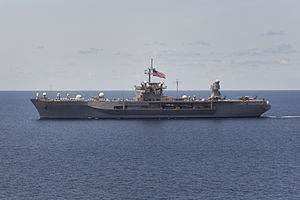The Royal Navy already has some unmanned underwater vehicles, such as the Remus 600 (Picture: Kraken Robotics).
Underwater technology
Aerial drones like the RAF’s Reapers are always under the supervision of a remote pilot, but radio waves do not work underwater, so the new robot submarines need to work without human assistance.
They will navigate and avoid obstacles on their own, taking decisions which would normally require the judgement of a human captain.
In 2016, Boeing launched the Echo Voyager, a 16-metre-long unmanned submarine, the largest ever built.
Like many manned submarines, it has hybrid diesel-electric power; the diesel is used when surfaced, batteries while submerged.
Echo Voyager is designed for long-range, long-duration missions. It has successfully completed thousands of hours of sea trials, including one three-month exercise off Southern California.
Earlier this year, the US Navy ordered four ‘Orca’ XLUUVs from Boeing which are expected to closely resemble Echo Voyager. Lockheed Martin also competed for this contract, and both companies are likely to take in interest in the Royal Navy’s requirements.
The US Navy ordered four ‘Orca’ XLUUVs from Boeing which are expected to closely resemble Echo Voyager, pictured above (Picture: Boeing).
Secret Missions
The MOD's competition is a Defence and Security Accelerator program to gain a better understanding of the limits and capabilities of autonomous submarines.
There’s £1m of research & development funding, with another £1.5m for field testing once the basic technology is proved.
The document lays out three vignettes describing the type of mission the unmanned submarines would carry out.
These are ‘sneakies’, clandestine operations requiring the sort of stealth and secrecy which the silent service has perfected.
Even these days, subs still sometimes return flying the skull and crossbones, the sign of a successful mission, with crews unable to discuss what they have been doing or where.
The Royal Navy has just seven fleet submarines of the Trafalgar and Astute class for such missions across the globe. Unmanned vessels would add extra capacity to carry out more operations in more places at the same time.
The MOD's competition is a Defence and Security Accelerator program to gain a better understanding of the limits and capabilities of autonomous submarines (Picture: Boeing).
The first vignette is for covert intelligence gathering.
This scenario requires the XLUUV to leave its dock and make its way unobserved to the operational area, where it monitors traffic for up to three months.
It would carry out electronic and optical intelligence gathering using a range of sensors. For example, it might release a tethered sensor to periscope depth to get pictures of passing vessels or activity ashore, or raise an aerial to listen in on radio traffic.
Even in the age of advanced satellite observation, subs can see things which spy satellites cannot. Although not in constant communication, the XLUUV reports back whenever it spots a ‘vessel of interest’.
The second vignette is similar but applies specifically to anti-submarine warfare.
In this scenario, underwater acoustic sensors would be the chief tool for identifying activity.
An unmanned submarine has an advantage, because it can wait completely silently, with no human movement on board.
Nuclear submarines cannot turn off their reactors entirely, so electric subs like the XLUUV also have an edge when it comes to engine noise.
According to the vignette, when a submarine is spotted, the XLUUV may continue monitoring or may be re-tasked, for example trailing the submarine it has picked up.
Nuclear submarines cannot turn off their reactors entirely, so electric subs also have an edge when it comes to engine noise (Pictutre: Royal Navy).
In the third vignette, the XLUUV is sent to covertly deploy a sensor payload to the seabed and recover it sometime later.
This type of sensor played a key role in the Cold War, keeping one step ahead of the Soviets.
It might be monitoring shipping, or it might be doing something smarter, such as tapping underwater communication cables.
More for Less
The competition document sets out a 12-month research and development phase, followed by 24 months of testing.
After that, the decision will be made on whether to proceed with an unmanned underwater force.
Orca XLUUVs are 175 times cheaper than a new Astute-class submarine (Picture: Royal Navy).
While robot submarines cannot match manned vessels in many ways, they are certainly cheaper.
The US Navy is paying just £8 million for each of its new Orca XLUUVs, compared to around £1.4 billion for a new Astute-class submarine, making them 175 times cheaper.
Dropping off a small sensor with a 7,000-ton nuclear-powered manned submarine is like delivering pizzas from a chauffeur-driven limo: the vehicle can certainly do the job well enough, but it may not be the most economical way of doing it.
A fleet of XLUUVs could give the Royal Navy vastly more capability for covert operations.
The robots might also take on
tasks like minelaying. This would free up the manned submarines to tackle the more challenging aspects of underwater warfare – such as those that require vessels equipped with missiles and torpedoes which still demand hands-on human control.










